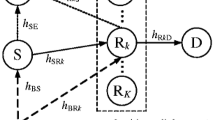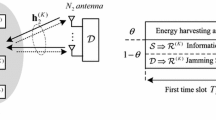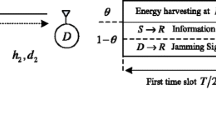Abstract
In this paper, a secure energy harvesting relay communication system with partial relay selection over Nakagami-m fading channels is proposed. A power beacon can provide wireless energy for the source and relay. A time-switching-based (TS) radio frequency energy harvesting technique is deployed at the power beacon. An eavesdropper is able to wiretap to the signal transmitted from the source and the relays. The exact closed-form expression of secrecy outage probability is derived. The results show that with increasing number of relays the system performs better in terms of secrecy outage probability (SOP). In addition, the energy harvesting duration has a significant effect on the secrecy outage probability. There exist an optimal energy harvesting duration that can achieve the lowest SOP and therefore this parameter should be carefully designed.
Access this chapter
Tax calculation will be finalised at checkout
Purchases are for personal use only
Similar content being viewed by others
References
Yuen, C., Elkashlan, M., Qian, Y., Duong, T.Q., Shu, L., Schmidt, F.: Energy harvesting communications: Part 1 [Guest Editorial]. IEEE Commun. Mag. 53(6), 54–55 (2015)
Yuen, C., Elkashlan, M., Qian, Y., Duong, T.Q., Shu, L., Schmidt, F.: Energy harvesting communications: Part 2 [Guest Editorial]. IEEE Commun. Mag. 53(6), 54–55 (2015)
Yuen, C., Elkashlan, M., Qian, Y., Duong, T.Q., Shu, L., Schmidt, F.: Energy harvesting communications: Part 3 [Guest Editorial]. IEEE Commun. Mag. 53(6), 54–55 (2015)
Zhong, C., Zheng, G., Zhang, Z., Karagiannidis, G.: Optimum wirelessly powered relaying. IEEE Signal Process. Lett. 22(10), 1–1 (2015)
Zhou, X., Zhang, R., Ho, C.K.: Wireless information and power transfer: Architecture design and rate-energy tradeoff. IEEE Trans. Commun. 61(11), 4754–4767 (2013)
Nasir, A.A., Zhou, X., Durrani, S., Kennedy, R.A.: Relaying protocols for wireless energy harvesting and information processing. IEEE Trans. Wirel. Commun. 12(7), 3622–3636 (2013)
Michalopoulos, D.S., Suraweera, H.A., Schober, R.: Relay selection for simultaneous information transmission and wireless energy transfer: A tradeoff perspective. IEEE J. Sel. Areas Commun. 33(8), 1 (2015)
Mohammadi, M., Chalise, B.K., Suraweera, H.A., Zhong, C., Zheng, G., Krikidis, I.: Throughput analysis and optimization of wireless-powered multiple antenna full-duplex relay systems. IEEE Trans. Commun. 64(4), 1769–1785 (2016)
Rankov, B., Wittneben, A.: Spectral efficient protocols for half-duplex fading relay channels. IEEE J. Sel. Areas Commun. 25(2), 379–389 (2007)
Bao, V.N.Q., Duong, T.Q., da Costa, D.B., Alexandropoulos, G.C., Nallanathan, A.: Cognitive amplify-and-forward relaying with best relay selection in non-identical Rayleigh fading. IEEE Commun. Lett. 17(3), 475–478 (2013)
Chen, G., Tian, Z., Gong, Y., Chambers, J.: Decode-and-forward buffer-aided relay selection in cognitive relay networks. IEEE Trans. Veh. Technol. 63(9), 4723–4728 (2014)
Yang, M., Guo, D., Huang, Y., Duong, T.Q., Zhang, B.: Secure multiuser scheduling in downlink dual-hop regenerative relay networks over Nakagami-\(m\) fading channels. IEEE Trans. Wireless Commun. 15(12), 8009–8024 (2016)
Fan, L., Lei, X., Yang, N., Duong, T.Q., Karagiannidis, G.K.: Secrecy cooperative networks with outdated relay selection over correlated fading channels. IEEE Trans. Veh. Technol. 66(8), 7599–7603 (2017)
Hoang, T.M., Duong, T.Q., Vo, N.S., Kundu, C.: Physical layer security in cooperative energy harvesting networks with a friendly jammer. IEEE Wirel. Commun. Lett. 6(2), 174–177 (2017)
Fan, L., Lei, X., Yang, N., Duong, T.Q., Karagiannidis, G.K.: Secure multiple amplify-and-forward relaying with cochannel interference. IEEE J. Sel. Topics Signal Process. 10(8), 1494–1505 (2016)
Duong, T.Q., Hoang, T.M., Kundu, C., Elkashlan, M., Nallanathan, A.: Optimal power allocation for multiuser secure communication in cooperative relaying networks. IEEE Wirel. Commun. Lett. 5(5), 516–519 (2016)
Huang, Y., Wang, J., Zhong, C., Duong, T.Q., Karagiannidis, G.K.: Secure transmission in cooperative relaying networks with multiple antennas. IEEE Trans. Wireless Commun. 15(10), 6843–6856 (2016)
Nguyen, N.P., Duong, T.Q., Ngo, H.Q., Hadzi-Velkov, Z., Shu, L.: Secure 5G wireless communications: A joint relay selection and wireless power transfer approach. IEEE Access 4, 3349–3359 (2016)
Fan, L., Yang, N., Duong, T.Q., Elkashlan, M., Karagiannidis, G.K.: Exploiting direct links for physical layer security in multiuser multirelay networks. IEEE Trans. Wireless Commun. 15(6), 3856–3867 (2016)
Hoang, T.M., Duong, T.Q., Suraweera, H.A., Tellambura, C., Poor, H.V.: Cooperative beamforming and user selection for improving the security of relay-aided systems. IEEE Trans. Wireless Commun. 63(12), 5039–5051 (2015)
Rodriguez, L.J., Tran, N.H., Duong, T.Q., Le-Ngoc, T., Elkashlan, M., Shetty, S.: Physical layer security in wireless cooperative relay networks: State of the art and beyond. IEEE Commun. Mag. 53(12), 32–39 (2015)
Wang, L., Kim, K.J., Duong, T.Q., Elkashlan, M., Poor, H.V.: Security enhancement of cooperative single carrier systems. IEEE Trans. Inf. Forensics Secur. 10(1), 90–103 (2015)
Fan, L., Lei, X., Duong, T.Q., Elkashlan, M., Karagiannidis, G.K.: Secure multiuser communications in multiple amplify-and-forward relay networks. IEEE Trans. Commun. 62(9), 3299–3310 (2014)
Wang, L., Elkashlan, M., Huang, J., Tran, N.H., Duong, T.Q.: Secure transmission with optimal power allocation in untrusted relay networks. IEEE Wirel. Commun. Lett. 3(3), 289–292 (2014)
Gradshteyn, I.S., Ryzhik, I.M.: Table of Integrals, Series, and Products, 7th edn. Academic press, San Diego (2007)
Author information
Authors and Affiliations
Corresponding author
Editor information
Editors and Affiliations
A Appendices
A Appendices
1.1 A.1 Proof of Lemma 1
The SNR of first hop and second hop in PRS scheme can be written as
The CDF of \(\gamma _{1\mathsf {PRS}}\) is expressed as
The CDF of \(\gamma _{2\mathsf {PRS}}\) is expressed as
The SOP of the considered system in PRS scheme is formulated as follows:
After performing some mathematical manipulations, (20) can be achieved with the help of [25, Eq. (3.471.9)].
Rights and permissions
Copyright information
© 2018 ICST Institute for Computer Sciences, Social Informatics and Telecommunications Engineering
About this paper
Cite this paper
Yin, C., He, X., Nguyen, NP., Garcia-Palacios, E. (2018). Secure Energy Harvesting Communications with Partial Relay Selection over Nakagami-m Fading Channels. In: Chen, Y., Duong, T. (eds) Industrial Networks and Intelligent Systems. INISCOM 2017. Lecture Notes of the Institute for Computer Sciences, Social Informatics and Telecommunications Engineering, vol 221. Springer, Cham. https://doi.org/10.1007/978-3-319-74176-5_10
Download citation
DOI: https://doi.org/10.1007/978-3-319-74176-5_10
Published:
Publisher Name: Springer, Cham
Print ISBN: 978-3-319-74175-8
Online ISBN: 978-3-319-74176-5
eBook Packages: Computer ScienceComputer Science (R0)




